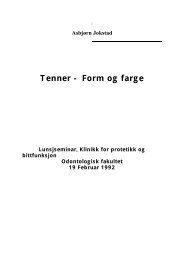Quality of dental restorations. FDI Commission Pro... - ResearchGate
Quality of dental restorations. FDI Commission Pro... - ResearchGate
Quality of dental restorations. FDI Commission Pro... - ResearchGate
Create successful ePaper yourself
Turn your PDF publications into a flip-book with our unique Google optimized e-Paper software.
146<strong>of</strong> <strong>restorations</strong> versus the incidence<strong>of</strong> later tooth fractures.Loss <strong>of</strong> restorationLoss <strong>of</strong> entire restoration is limitedmostly to Class V <strong>restorations</strong>,especially when placed withoutcavity preparation. Loss <strong>of</strong> othertypes <strong>of</strong> <strong>restorations</strong> would onlyoccur due to inappropriate selection<strong>of</strong> material, improper preparation<strong>of</strong> the tooth before restoration,violation <strong>of</strong> biomechanical principlesfor designing the restoration,mishandling the material, or acombination <strong>of</strong> these factors.Material factorsDeviations from the manufacturer’sdirection for use may lead todecreased clinical performance. Thishas been reported in a three-yearstudy <strong>of</strong> resin-modified glassionomercements placed in cervicalcavities, where retention wasassociated with surface wettingfollowing variations in the powder/liquid ratio at the time <strong>of</strong> placement277 .Much discussion has taken placeon the importance <strong>of</strong> the modulus<strong>of</strong> elasticity <strong>of</strong> polymeric materials278 . There are diverging views onits relevance, and this confusion typifiesour poor understanding <strong>of</strong>tooth biomechanics. There is alsoan ongoing discussion about whichmaterial is most appropriate fornon-carious cervical lesions. Iscomposite resin, glass-ionomercement, polyacid-modified compositeor resin-modified glass-ionomercement the optimal material <strong>of</strong>choice 279,280 ?Operator factorsAlthough presented as anecdotalevidence, Friedman 281 recounts hisclinical experiences after placing asubstantial number <strong>of</strong> porcelainveneers (n=3,500) over 15 years.The author attributes the three mainfailure reasons (debonding, marginaldiscolouration and adhesive fractures)to poor bonding, which isan indirect indication <strong>of</strong> impropertooth preparation or materialhandling. It has been suggested thatthe effectiveness <strong>of</strong> dentine bonding,and thus the retention <strong>of</strong><strong>restorations</strong>, is influenced byoperator factors such as cavitypreparation relative to the activecaries process, technique for materialapplication, and procedures forpolishing 282 .Cavity designVital dentine is continuously remodellingits microstructure to respondto physiological and pathologicalchanges. Therefore, bonding mayencounter differences such assclerotic dentine, hypersensitivedentine (with open tubules), cariesaffectedareas, superficial dentinewith few tubules, or deep dentinelayers close to the pulp 283 .IsolationCervical composite resin <strong>restorations</strong>placed with isolation eitherwith rubber dam or with cottonrolls suggested no statisticallysignificant differences in retentionafter two years <strong>of</strong> service. Thus,loss <strong>of</strong> retention was not differentwhen a careful cotton roll techniquewas used as a moisturecontrol method, as long as salivacontamination was avoided 174 .Patient factorsGender and ageIt has been suggested that bondingto sclerotic dentine is less reliablethan to young dentine, at least witholder restorative materials 284 . Tworecent clinical studies have refutedthe hypothesis 285,286 . In these studies,lower failure frequencies wereseen in the oldest age groups andthe <strong>restorations</strong> placed in scleroticdentine had an almost equal failurerate compared to the ones placedin non-sclerotic lesions.McCoy et al. 191 suggested, aftera three-year longitudinal study <strong>of</strong>Class V composite resin <strong>restorations</strong>,that a high proportion <strong>of</strong> oldpatients in the study contributed torelatively high proportion <strong>of</strong> loss,as a result <strong>of</strong> changes in the character<strong>of</strong> the dentinal surface.Heymann et al. 287 reported onthe determinants <strong>of</strong> failure <strong>of</strong> bondedcomposite resin <strong>restorations</strong> in noncariouscervical lesions. A strongassociation between patient age andrestoration loss was identified,which was attributed to the greatertooth flexure in older patients, andthe smooth, sclerotic nature <strong>of</strong> ‘old’dentine.Oral environmentIn a recount <strong>of</strong> a clinical experienceafter placing 3,500 porcelainveneers over 15 years, Friedman 281distinguishes between three fracturetypes, and suggests the aetiologicalmechanism for each type. Theauthor ascribed static fracture linesand cohesive fractures to excessiveloading.McCoy et al. 191 noted in a threeyearlongitudinal study <strong>of</strong> Class Vcomposite resin <strong>restorations</strong> thatsome <strong>restorations</strong> were lost fromteeth with marked signs <strong>of</strong> occlusalwear, supporting earlier reports <strong>of</strong>higher loss <strong>of</strong> <strong>restorations</strong> amongbruxers compared to non-bruxers 288 .Does technical excellencepredict failure?There are no known papers thathave reported any associationbetween clinical observations <strong>of</strong>technical excellence <strong>of</strong> <strong>restorations</strong>versus later loss <strong>of</strong> <strong>restorations</strong>.Orthodontic changes andtemporomandibular jointproblemsComposite resins placed during1970–1980 had relatively poorresistance to wear when used in theposterior occlusal segments. In spite<strong>of</strong> this, products were sold in largequantities and used for thispurpose by many general practitioners.Annual wear <strong>of</strong> 30–60mmwas reported, raising concerns forpossible hypereruption <strong>of</strong> opposingteeth and mesial migration <strong>of</strong>teeth distal to those undergoing lossInternational Dental Journal (2001) Vol. 51/No.3


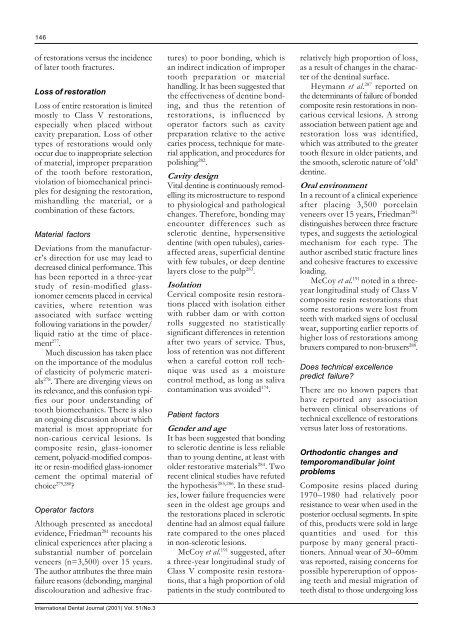
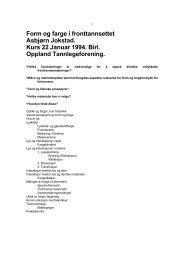
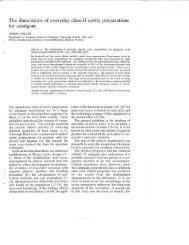
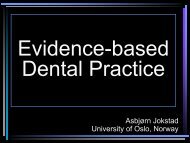
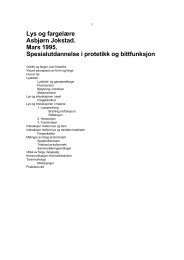
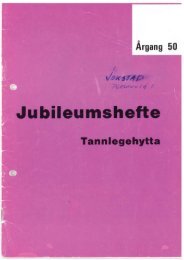
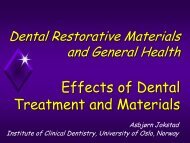
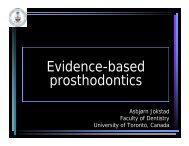

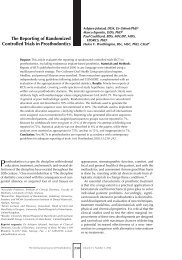
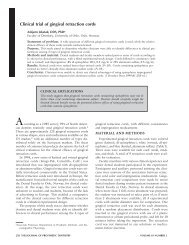

![[Sementer i fast protetikk] Scandinavian Society for Prosthetic](https://img.yumpu.com/18378889/1/190x245/sementer-i-fast-protetikk-scandinavian-society-for-prosthetic.jpg?quality=85)
